Magnetic resonance imaging
| Magnetic resonance imaging | |
|---|---|
Para-sagittalMRI of the head, withaliasingartifacts(nose and forehead appear at the back of the head) | |
| Synonyms | Nuclear magnetic resonance imaging (NMRI), magnetic resonance tomography (MRT) |
| ICD-9-CM | 88.91 |
| MeSH | D008279 |
| MedlinePlus | 003335 |
Magnetic resonance imaging(MRI) is amedical imagingtechnique used inradiologyto form pictures of theanatomyand thephysiologicalprocesses inside the body.MRI scannersuse strongmagnetic fields,magnetic field gradients, andradio wavesto generate images of the organs in the body. MRI does not involveX-raysor the use ofionizing radiation,which distinguishes it fromcomputed tomography(CT) andpositron emission tomography(PET) scans. MRI is amedical applicationofnuclear magnetic resonance(NMR) which can also be used for imaging in otherNMR applications,such asNMR spectroscopy.[1]
MRI is widely used in hospitals and clinics formedical diagnosis,stagingand follow-up of disease. Compared to CT, MRI provides better contrast in images of soft tissues, e.g. in thebrainor abdomen. However, it may be perceived as less comfortable by patients, due to the usually longer and louder measurements with the subject in a long, confining tube, although "open" MRI designs mostly relieve this. Additionally,implantsand other non-removable metal in the body can pose a risk and may exclude some patients from undergoing an MRI examination safely.
MRI was originally called NMRI (nuclear magnetic resonance imaging), but "nuclear" was dropped to avoidnegative associations.[2]Certainatomic nucleiare able to absorbradio frequency(RF) energy when placed in an externalmagnetic field;the resultant evolvingspin polarizationcan induce aRFsignal in a radio frequency coil and thereby be detected.[3]In other words, the nuclear magnetic spin of protons in the hydrogen nuclei resonates with the RF incident waves and emit coherent radiation with compact direction, energy (frequency) and phase. This coherent amplified radiation is easily detected by RF antenas close to the subject being examined. It is a process similar tomasers.In clinical and research MRI,hydrogen atomsare most often used to generate a macroscopic polarized radiation that is detected by the antennas.[3]Hydrogen atoms arenaturally abundant in humansand other biological organisms, particularly inwaterandfat.For this reason, most MRI scans essentially map the location of water and fat in the body. Pulses of radio waves excite thenuclear spinenergy transition, and magnetic field gradients localize the polarization in space. By varying the parameters of thepulse sequence,different contrasts may be generated between tissues based on therelaxationproperties of the hydrogen atoms therein.
Since its development in the 1970s and 1980s, MRI has proven to be a versatile imaging technique. While MRI is most prominently used indiagnostic medicineand biomedical research, it also may be used to form images of non-living objects, such asmummies.Diffusion MRIandfunctional MRIextend the utility of MRI to capture neuronal tracts and blood flow respectively in the nervous system, in addition to detailed spatial images. The sustained increase in demand for MRI withinhealth systemshas led to concerns aboutcost effectivenessandoverdiagnosis.[4][5][dubious–discuss]
Mechanism
[edit]Construction and physics
[edit]
In most medical applications,hydrogennuclei, which consist solely of aproton,that are in tissues create a signal that is processed to form an image of the body in terms of the density of those nuclei in a specific region. Given that the protons are affected by fields from other atoms to which they are bonded, it is possible to separate responses from hydrogen in specific compounds. To perform a study, the person is positioned within anMRI scannerthat forms a strongmagnetic fieldaround the area to be imaged. First, energy from anoscillatingmagnetic field is temporarily applied to the patient at the appropriateresonancefrequency. Scanning with X and Y gradient coils causes a selected region of the patient to experience the exact magnetic field required for the energy to be absorbed. The atoms areexcitedby aRFpulse and the resultant signal is measured by areceiving coil.The RF signal may be processed to deduce position information by looking at the changes in RF level and phase caused by varying the local magnetic field usinggradient coils.As these coils are rapidly switched during the excitation and response to perform a moving line scan, they create the characteristic repetitive noise of an MRI scan as the windings move slightly due tomagnetostriction.The contrast between different tissues is determined by the rate at which excited atoms return to theequilibrium state.Exogenouscontrast agentsmay be given to the person to make the image clearer.[6]
The major components of an MRI scanner are the mainmagnet,which polarizes the sample, theshim coilsfor correcting shifts in thehomogeneityof the main magnetic field, the gradient system which is used to localize the region to be scanned and the RF system, which excites the sample and detects the resulting NMR signal. The whole system is controlled by one or more computers.
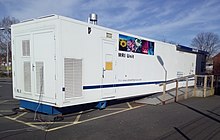
MRI requires a magnetic field that is both strong anduniformto a few parts per million across the scan volume. The field strength of the magnet is measured inteslas– and while the majority of systems operate at 1.5 T, commercial systems are available between 0.2 and 7 T. Whole-body MRI systems for research applications operate in e.g. 9.4T,[7][8]10.5T,[9]11.7T.[10]Even higher field whole-body MRI systems e.g. 14 T and beyond are in conceptual proposal[11]or in engineering design.[12]Most clinical magnets aresuperconductingmagnets, which requireliquid heliumto keep them at low temperatures. Lower field strengths can be achieved with permanent magnets, which are often used in "open" MRI scanners forclaustrophobicpatients.[13]Lower field strengths are also used in aportable MRIscanner approved by the FDA in 2020.[14]Recently, MRI has been demonstrated also at ultra-low fields, i.e., in the microtesla-to-millitesla range, where sufficient signal quality is made possible by prepolarization (on the order of 10–100 mT) and by measuring theLarmor precessionfields at about 100 microtesla with highly sensitive superconducting quantum interference devices (SQUIDs).[15][16][17]
T1 and T2
[edit]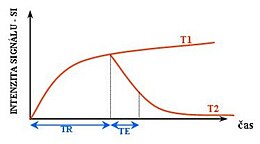


Each tissue returns to its equilibrium state after excitation by the independent relaxation processes of T1(spin-lattice;that is, magnetization in the same direction as the static magnetic field) and T2(spin-spin;transverse to the static magnetic field). To create a T1-weighted image, magnetization is allowed to recover before measuring the MR signal by changing therepetition time(TR). This image weighting is useful for assessing the cerebral cortex, identifying fatty tissue, characterizing focal liver lesions, and in general, obtaining morphological information, as well as forpost-contrastimaging. To create a T2-weighted image, magnetization is allowed to decay before measuring the MR signal by changing theecho time(TE). This image weighting is useful for detectingedemaand inflammation, revealingwhite matter lesions,and assessing zonal anatomy in theprostateanduterus.
The information from MRI scans comes in the form ofimage contrastsbased on differences in the rate of relaxation ofnuclear spinsfollowing their perturbation by an oscillating magnetic field (in the form of radiofrequency pulses through the sample).[18]The relaxation rates are a measure of the time it takes for a signal to decay back to an equilibrium state from either the longitudinal or transverse plane.
Magnetizationbuilds up along the z-axis in the presence of a magnetic field, B0,such that themagnetic dipolesin the sample will, on average, align with the z-axis summing to a total magnetization Mz.This magnetization along z is defined as the equilibrium magnetization; magnetization is defined as the sum of all magnetic dipoles in a sample. Following the equilibrium magnetization, a 90° radiofrequency (RF) pulse flips the direction of the magnetization vector in the xy-plane, and is then switched off. The initial magnetic field B0,however, is still applied. Thus, the spin magnetization vector will slowly return from the xy-plane back to the equilibrium state. The time it takes for the magnetization vector to return to its equilibrium value, Mz,is referred to as the longitudinal relaxation time, T1.[19]Subsequently, the rate at which this happens is simply the reciprocal of the relaxation time:.Similarly, the time in which it takes for Mxyto return to zero is T2,with the rate.[20]Magnetization as a function of time is defined by theBloch equations.
T1and T2values are dependent on the chemical environment of the sample; hence their utility in MRI. Soft tissue and muscle tissue relax at different rates, yielding the image contrast in a typical scan.
The standard display of MR images is to represent fluid characteristics inblack-and-whiteimages, where different tissues turn out as follows:
| Signal | T1-weighted | T2-weighted |
|---|---|---|
| High |
|
|
| Intermediate | Gray matterdarker thanwhite matter[23] | White matterdarker thangrey matter[23] |
| Low |
|
|
Diagnostics
[edit]Usage by organ or system
[edit]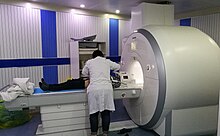
MRI has a wide range of applications inmedical diagnosisand around 50,000 scanners are estimated to be in use worldwide.[24]MRI affects diagnosis and treatment in many specialties although the effect on improved health outcomes is disputed in certain cases.[25][26]

MRI is the investigation of choice in the preoperativestagingofrectalandprostate cancerand has a role in the diagnosis, staging, and follow-up of other tumors,[27]as well as for determining areas of tissue for sampling in biobanking.[28][29]
Neuroimaging
[edit]
MRI is the investigative tool of choice for neurological cancers over CT, as it offers better visualization of theposterior cranial fossa,containing thebrainstemand thecerebellum.The contrast provided betweengreyandwhite mattermakes MRI the best choice for many conditions of thecentral nervous system,includingdemyelinating diseases,dementia,cerebrovascular disease,infectious diseases,Alzheimer's diseaseandepilepsy.[30][31][32]Since many images are taken milliseconds apart, it shows how the brain responds to different stimuli, enabling researchers to study both the functional and structural brain abnormalities in psychological disorders.[33]MRI also is used inguidedstereotactic surgeryandradiosurgeryfor treatment of intracranial tumors, arteriovenous malformations, and other surgically treatable conditions using a device known as theN-localizer.[34][35][36]New tools that implementartificial intelligence in healthcarehave demonstrated higher image quality and morphometric analysis inneuroimagingwith the application of a denoising system.[37]
The record for the highest spatial resolution of a whole intact brain (postmortem) is 100 microns, from Massachusetts General Hospital. The data was published in NATURE on 30 October 2019.[38][39]
Though MRI is used widely in research on mental disabilities, based on a 2024 systematic literature review and meta analysis commissioned by the Patient-Centered Outcomes Research Institute (PCORI), available research using MRI scans to diagnose ADHD showed great variability.[40]The authors conclude that MRI cannot be reliably used to assist in making a clinical diagnosis of ADHD.[40]
Cardiovascular
[edit]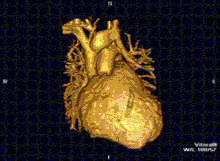
Cardiac MRI is complementary to other imaging techniques, such asechocardiography,cardiac CT,andnuclear medicine.It can be used to assess the structure and the function of the heart.[41]Its applications include assessment ofmyocardial ischemia and viability,cardiomyopathies,myocarditis,iron overload,vascular diseases, andcongenital heart disease.[42]
Musculoskeletal
[edit]Applications in the musculoskeletal system includespinal imaging,assessment ofjointdisease, andsoft tissue tumors.[43]Also, MRI techniques can be used for diagnostic imaging of systemic muscle diseasesincluding genetic muscle diseases.[44][45]
Swallowing movement of throat and oesophagus can cause motion artifact over the imaged spine. Therefore, a saturation pulse[clarification needed]applied over this region the throat and oesophagus can help to avoid this artifact. Motion artifact arising due to pumping of the heart can be reduced by timing the MRI pulse according to heart cycles.[46]Blood vessels flow artifacts can be reduced by applying saturation pulses above and below the region of interest.[47]
Liver and gastrointestinal
[edit]HepatobiliaryMR is used to detect and characterize lesions of theliver,pancreas,andbile ducts.Focal or diffuse disorders of the liver may be evaluated usingdiffusion-weighted,opposed-phase imaging anddynamic contrast enhancementsequences. Extracellular contrast agents are used widely in liver MRI, and newer hepatobiliary contrast agents also provide the opportunity to perform functional biliary imaging. Anatomical imaging of the bile ducts is achieved by using a heavily T2-weighted sequence in magnetic resonance cholangiopancreatography (MRCP). Functional imaging of the pancreas is performed following administration ofsecretin.MR enterography provides non-invasive assessment of inflammatory bowel disease and small bowel tumors. MR-colonography may play a role in the detection of large polyps in patients at increased risk of colorectal cancer.[48][49][50][51]
Angiography
[edit]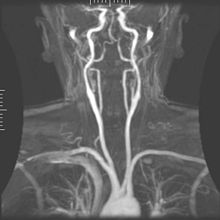
Magnetic resonanceangiography(MRA) generates pictures of the arteries to evaluate them forstenosis(abnormal narrowing) oraneurysms(vessel wall dilatations, at risk of rupture). MRA is often used to evaluate the arteries of the neck and brain, the thoracic and abdominal aorta, the renal arteries, and the legs (called a "run-off" ). A variety of techniques can be used to generate the pictures, such as administration of aparamagneticcontrast agent (gadolinium) or using a technique known as "flow-related enhancement" (e.g., 2D and 3D time-of-flight sequences), where most of the signal on an image is due to blood that recently moved into that plane (see alsoFLASH MRI).[52]
Techniques involving phase accumulation (known as phase contrast angiography) can also be used to generate flow velocity maps easily and accurately. Magnetic resonance venography (MRV) is a similar procedure that is used to image veins. In this method, the tissue is now excited inferiorly, while the signal is gathered in the plane immediately superior to the excitation plane—thus imaging the venous blood that recently moved from the excited plane.[53]
Contrast agents
[edit]MRI for imaging anatomical structures or blood flow do not require contrast agents since the varying properties of the tissues or blood provide natural contrasts. However, for more specific types of imaging,exogenouscontrast agents may be givenintravenously,orally,orintra-articularly.[6]Most contrast agents are either paramagnetic (e.g.: gadolinium, manganese, europium), and are used to shorten T1 in the tissue they accumulate in, or super-paramagnetic (SPIONs), and are used to shorten T2 and T2* in healthy tissue reducing its signal intensity (negative contrast agents). The most commonly used intravenous contrast agents are based onchelatesofgadolinium,which is highly paramagnetic.[54]In general, these agents have proved safer than the iodinated contrast agents used in X-ray radiography or CT.Anaphylactoid reactionsare rare, occurring in approx. 0.03–0.1%.[55]Of particular interest is the lower incidence of nephrotoxicity, compared with iodinated agents, when given at usual doses—this has made contrast-enhanced MRI scanning an option for patients with renal impairment, who would otherwise not be able to undergocontrast-enhanced CT.[56]
Gadolinium-based contrast reagents are typicallyoctadentatecomplexes ofgadolinium(III).The complex isvery stable(log K > 20) so that, in use, the concentration of the un-complexed Gd3+ions should be below the toxicity limit. The 9th place in the metal ion'scoordination sphereis occupied by a water molecule which exchanges rapidly with water molecules in the reagent molecule's immediate environment, affecting the magnetic resonancerelaxation time.[57]
In December 2017, theFood and Drug Administration(FDA) in theUnited Statesannounced in a drug safety communication that new warnings were to be included on all gadolinium-based contrast agents (GBCAs). The FDA also called for increased patient education and requiring gadolinium contrast vendors to conduct additional animal and clinical studies to assess the safety of these agents.[58] Although gadolinium agents have proved useful for patients with kidney impairment, in patients with severekidney failurerequiring dialysis there is a risk of a rare but serious illness,nephrogenic systemic fibrosis,which may be linked to the use of certain gadolinium-containing agents. The most frequently linked isgadodiamide,but other agents have been linked too.[59]Although a causal link has not been definitively established, current guidelines in theUnited Statesare that dialysis patients should only receive gadolinium agents where essential and thatdialysisshould be performed as soon as possible after the scan to remove the agent from the body promptly.[60][61]
In Europe, where more gadolinium-containing agents are available, a classification of agents according to potential risks has been released.[62][63]In 2008, a new contrast agent namedgadoxetate,brand name Eovist (US) or Primovist (EU), was approved for diagnostic use: This has the theoretical benefit of a dual excretion path.[64]
Sequences
[edit]AnMRI sequenceis a particular setting of radiofrequency pulses and gradients, resulting in a particular image appearance.[65]TheT1 and T2weighting can also be described as MRI sequences.
Overview table
This table does not includeuncommon and experimental sequences.
| Group | Sequence | Abbr. | Physics | Main clinical distinctions | Example |
|---|---|---|---|---|---|
| Spin echo | T1 weighted | T1 | Measuringspin–lattice relaxationby using a shortrepetition time(TR) andecho time(TE). |
Standard foundation and comparison for other sequences |

|
| T2 weighted | T2 | Measuringspin–spin relaxationby using long TR and TE times |
Standard foundation and comparison for other sequences |

| |
| Proton density weighted | PD | LongTR(to reduce T1) and shortTE(to minimize T2).[69] | Joint diseaseand injury.[70]
|

| |
| Gradient echo(GRE) | Steady-state free precession | SSFP | Maintenance of a steady, residual transverse magnetisation over successive cycles.[72] | Creation ofcardiac MRIvideos (pictured).[72] | 
|
| Effective T2 or "T2-star" |
T2* | Spoiled gradient recalled echo (GRE) with a long echo time and small flip angle[73] | Low signal fromhemosiderindeposits (pictured) and hemorrhages.[73] | 
| |
| Susceptibility-weighted | SWI | Spoiled gradient recalled echo (GRE), fully flow compensated, long echo time, combines phase image with magnitude image[74] | Detecting small amounts of hemorrhage (diffuse axonal injurypictured) or calcium.[74] | 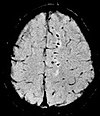
| |
| Inversion recovery | Short tau inversion recovery | STIR | Fat suppression by setting aninversion timewhere the signal of fat is zero.[75] | High signal inedema,such as in more severestress fracture.[76]Shin splintspictured: | 
|
| Fluid-attenuated inversion recovery | FLAIR | Fluid suppression by setting an inversion time that nulls fluids | High signal inlacunar infarction,multiple sclerosis (MS) plaques,subarachnoid haemorrhageandmeningitis(pictured).[77] | 
| |
| Double inversion recovery | DIR | Simultaneous suppression ofcerebrospinal fluidandwhite matterby two inversion times.[78] | High signal ofmultiple sclerosisplaques (pictured).[78] | 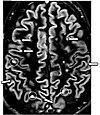
| |
| Diffusion weighted(DWI) | Conventional | DWI | Measure ofBrownian motionof water molecules.[79] | High signal within minutes ofcerebral infarction(pictured).[80] | 
|
| Apparent diffusion coefficient | ADC | Reduced T2 weighting by taking multiple conventional DWI images with different DWI weighting, and the change corresponds to diffusion.[81] | Low signal minutes aftercerebral infarction(pictured).[82] | 
| |
| Diffusion tensor | DTI | Mainlytractography(pictured) by an overall greaterBrownian motionof water molecules in the directions of nerve fibers.[83] |
|
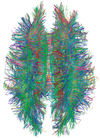
| |
| Perfusion weighted(PWI) | Dynamic susceptibility contrast | DSC | Measures changes over time in susceptibility-induced signal loss due togadolinium contrastinjection.[85] |
|

|
| Arterial spin labelling | ASL | Magnetic labeling of arterial blood below the imaging slab, which subsequently enters the region of interest.[87]It does not need gadolinium contrast.[88] | |||
| Dynamic contrast enhanced | DCE | Measures changes over time in the shortening of thespin–lattice relaxation(T1) induced by agadolinium contrastbolus.[89] | Faster Gd contrast uptake along with other features is suggestive of malignancy (pictured).[90] | 
| |
| Functional MRI(fMRI) | Blood-oxygen-level dependentimaging | BOLD | Changes inoxygen saturation-dependent magnetism ofhemoglobinreflects tissue activity.[91] | Localizing brain activity from performing an assigned task (e.g. talking, moving fingers) before surgery, also used in research of cognition.[92] | 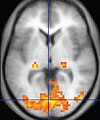
|
| Magnetic resonance angiography(MRA) and venography | Time-of-flight | TOF | Blood entering the imaged area is not yetmagnetically saturated,giving it a much higher signal when using short echo time and flow compensation. | Detection ofaneurysm,stenosis,ordissection[93] | 
|
| Phase-contrast magnetic resonance imaging | PC-MRA | Two gradients with equal magnitude, but opposite direction, are used to encode a phase shift, which is proportional to the velocity ofspins.[94] | Detection ofaneurysm,stenosis,ordissection(pictured).[93] |  (VIPR) |
Specialized configurations
[edit]Magnetic resonance spectroscopy
[edit]Magnetic resonance spectroscopy(MRS) is used to measure the levels of differentmetabolitesin body tissues, which can be achieved through a variety of single voxel or imaging-based techniques.[95]The MR signal produces a spectrum of resonances that corresponds to different molecular arrangements of the isotope being "excited". This signature is used to diagnose certain metabolic disorders, especially those affecting the brain,[96]and to provide information on tumormetabolism.[97]
Magnetic resonance spectroscopic imaging (MRSI) combines both spectroscopic and imaging methods to produce spatially localized spectra from within the sample or patient. The spatial resolution is much lower (limited by the availableSNR), but the spectra in each voxel contains information about many metabolites. Because the available signal is used to encode spatial and spectral information, MRSI requires high SNR achievable only at higher field strengths (3 T and above).[98]The high procurement and maintenance costs of MRI with extremely high field strengths[99]inhibit their popularity. However, recentcompressed sensing-based software algorithms (e.g.,SAMV[100]) have been proposed to achievesuper-resolutionwithout requiring such high field strengths.
Real-time
[edit]Real-time magnetic resonance imaging(RT-MRI) refers to the continuous monitoring of moving objects in real time. Traditionally, real-time MRI was possible only with low image quality or low temporal resolution. Aniterative reconstructionalgorithm removed limitations. RadialFLASH MRI(real-time) yields a temporal resolution of 20 to 30 milliseconds for images with an in-plane resolution of 1.5 to 2.0 mm.[102]Real-time MRI adds information about diseases of thejointsand theheart.In many cases MRI examinations become easier and more comfortable for patients, especially for the patients who cannot calm their breathing[103]or who havearrhythmia.
Balanced steady-state free precession (bSSFP) imaginggives better image contrast between the blood pool and myocardium than FLASH MRI, at the cost of severe banding artifact when B0 inhomogeneity is strong.[103]Interventional MRI
[edit]The lack of harmful effects on the patient and the operator make MRI well-suited forinterventional radiology,where the images produced by an MRI scanner guide minimally invasive procedures. Such procedures use noferromagneticinstruments.[104]
A specialized growing subset ofinterventional MRIisintraoperative MRI,in which an MRI is used in surgery. Some specialized MRI systems allow imaging concurrent with the surgical procedure. More typically, the surgical procedure is temporarily interrupted so that MRI can assess the success of the procedure or guide subsequent surgical work.[105]
Magnetic resonance guided focused ultrasound
[edit]In guided therapy,high-intensity focused ultrasound(HIFU) beams are focused on a tissue, that are controlled using MR thermal imaging. Due to the high energy at the focus, the temperature rises to above 65°C(150 °F) which completely destroys the tissue. This technology can achieve preciseablationof diseased tissue. MR imaging provides a three-dimensional view of the target tissue, allowing for the precise focusing of ultrasound energy. The MR imaging provides quantitative, real-time, thermal images of the treated area. This allows the physician to ensure that the temperature generated during each cycle of ultrasound energy is sufficient to cause thermal ablation within the desired tissue and if not, to adapt the parameters to ensure effective treatment.[106]
Multinuclear imaging
[edit]Hydrogen has the most frequently imagednucleusin MRI because it is present in biological tissues in great abundance, and because its highgyromagnetic ratiogives a strong signal. However, any nucleus with a netnuclear spincould potentially be imaged with MRI. Such nuclei includehelium-3,lithium-7,carbon-13,fluorine-19,oxygen-17,sodium-23,phosphorus-31 andxenon-129.23Na and31P are naturally abundant in the body, so they can be imaged directly. Gaseous isotopes such as3He or129Xe must behyperpolarizedand then inhaled as their nuclear density is too low to yield a useful signal under normal conditions.17Oand19F can be administered in sufficient quantities in liquid form (e.g.17O-water) that hyperpolarization is not a necessity.[107]Using helium or xenon has the advantage of reduced background noise, and therefore increased contrast for the image itself, because these elements are not normally present in biological tissues.[108]
Moreover, the nucleus of any atom that has a net nuclear spin and that is bonded to a hydrogen atom could potentially be imaged via heteronuclear magnetization transfer MRI that would image the high-gyromagnetic-ratio hydrogen nucleus instead of the low-gyromagnetic-ratio nucleus that is bonded to the hydrogen atom.[109]In principle, heteronuclear magnetization transfer MRI could be used to detect the presence or absence of specific chemical bonds.[110][111]
Multinuclear imaging is primarily a research technique at present. However, potential applications include functional imaging and imaging of organs poorly seen on1H MRI (e.g., lungs and bones) or as alternative contrast agents. Inhaled hyperpolarized3He can be used to image the distribution of air spaces within the lungs. Injectable solutions containing13C or stabilized bubbles of hyperpolarized129Xe have been studied as contrast agents for angiography and perfusion imaging.31P can potentially provide information on bone density and structure, as well as functional imaging of the brain. Multinuclear imaging holds the potential to chart the distribution of lithium in the human brain, this element finding use as an important drug for those with conditions such as bipolar disorder.[112]
Molecular imaging by MRI
[edit]MRI has the advantages of having very high spatial resolution and is very adept at morphological imaging and functional imaging. MRI does have several disadvantages though. First, MRI has a sensitivity of around 10−3mol/Lto 10−5mol/L, which, compared to other types of imaging, can be very limiting. This problem stems from the fact that the population difference between the nuclear spin states is very small at room temperature. For example, at 1.5teslas,a typical field strength for clinical MRI, the difference between high and low energy states is approximately 9 molecules per 2 million. Improvements to increase MR sensitivity include increasing magnetic field strength andhyperpolarizationvia optical pumping or dynamic nuclear polarization. There are also a variety of signal amplification schemes based on chemical exchange that increase sensitivity.[113]
To achieve molecular imaging of disease biomarkers using MRI, targeted MRIcontrast agentswith high specificity and high relaxivity (sensitivity) are required. To date, many studies have been devoted to developing targeted-MRI contrast agents to achieve molecular imaging by MRI. Commonly, peptides, antibodies, or small ligands, and small protein domains, such as HER-2 affibodies, have been applied to achieve targeting. To enhance the sensitivity of the contrast agents, these targeting moieties are usually linked to high payload MRI contrast agents or MRI contrast agents with high relaxivities.[114]A new class of gene targeting MR contrast agents has been introduced to show gene action of unique mRNA and gene transcription factor proteins.[115][116]These new contrast agents can trace cells with unique mRNA, microRNA and virus; tissue response to inflammation in living brains.[117]The MR reports change in gene expression with positive correlation to TaqMan analysis, optical and electron microscopy.[118]
Parallel MRI
[edit]It takes time to gather MRI data using sequential applications of magnetic field gradients. Even for the most streamlined ofMRI sequences,there are physical and physiologic limits to the rate of gradient switching. Parallel MRI circumvents these limits by gathering some portion of the data simultaneously, rather than in a traditional sequential fashion. This is accomplished using arrays of radiofrequency (RF) detector coils, each with a different 'view' of the body. A reduced set of gradient steps is applied, and the remaining spatial information is filled in by combining signals from various coils, based on their known spatial sensitivity patterns. The resulting acceleration is limited by the number of coils and by the signal to noise ratio (which decreases with increasing acceleration), but two- to four-fold accelerations may commonly be achieved with suitable coil array configurations, and substantially higher accelerations have been demonstrated with specialized coil arrays. Parallel MRI may be used with mostMRI sequences.
After a number of early suggestions for using arrays of detectors to accelerate imaging went largely unremarked in the MRI field, parallel imaging saw widespread development and application following the introduction of the SiMultaneous Acquisition of Spatial Harmonics (SMASH) technique in 1996–7.[119]The SENSitivity Encoding (SENSE)[120]and Generalized Autocalibrating Partially Parallel Acquisitions (GRAPPA)[121]techniques are the parallel imaging methods in most common use today. The advent of parallel MRI resulted in extensive research and development in image reconstruction and RF coil design, as well as in a rapid expansion of the number of receiver channels available on commercial MR systems. Parallel MRI is now used routinely for MRI examinations in a wide range of body areas and clinical or research applications.
Quantitative MRI
[edit]Most MRI focuses on qualitative interpretation of MR data by acquiring spatial maps of relative variations in signal strength which are "weighted" by certain parameters.[122]Quantitative methods instead attempt to determine spatial maps of accurate tissue relaxometry parameter values or magnetic field, or to measure the size of certain spatial features.
Examples of quantitative MRI methods are:
- T1-mapping (notably used incardiac magnetic resonance imaging[123])
- T2-mapping[124]
- Quantitative susceptibility mapping(QSM)
- Quantitative fluid flow MRI (i.e. somecerebrospinal fluid flow MRI[125])
- Magnetic resonance elastography(MRE)[126]
Quantitative MRI aims to increase thereproducibilityof MR images and interpretations, but has historically require longer scan times.[122]
Quantitative MRI (or qMRI) sometimes more specifically refers to multi-parametric quantitative MRI, the mapping of multiple tissue relaxometry parameters in a single imaging session.[127] Efforts to make multi-parametric quantitative MRI faster have produced sequences which map multiple parameters simultaneously, either by building separate encoding methods for each parameter into the sequence,[128] or by fitting MR signal evolution to a multi-parameter model.[129][130]
Hyperpolarized gas MRI
[edit]Traditional MRI generates poor images of lung tissue because there are fewer water molecules with protons that can be excited by the magnetic field. Using hyperpolarized gas an MRI scan can identify ventilation defects in the lungs. Before the scan, a patient is asked to inhale hyperpolarizedxenonmixed with a buffer gas of helium or nitrogen. The resulting lung images are much higher quality than with traditional MRI.
Safety
[edit]MRI is, in general, a safe technique, although injuries may occur as a result of failed safety procedures or human error.[131]Contraindicationsto MRI include mostcochlear implantsandcardiac pacemakers,shrapnel,and metallicforeign bodiesin theeyes.Magnetic resonance imaging in pregnancyappears to be safe, at least during the second and thirdtrimestersif done without contrast agents.[132]Since MRI does not use any ionizing radiation, its use is generally favored in preference toCTwhen either modality could yield the same information.[133]Some patients experience claustrophobia and may require sedation or shorter MRI protocols.[134][135]Amplitude and rapid switching of gradient coils during image acquisition may cause peripheral nerve stimulation.[136]
MRI uses powerful magnets and can therefore causemagnetic materialsto move at great speeds, posing a projectile risk, and may cause fatal accidents.[137]However, as millions of MRIs are performed globally each year,[138]fatalities are extremely rare.[139]
MRI machines can produce loud noise, up to 120dB(A).[140]This can causehearing loss,tinnitusandhyperacusis,so appropriatehearing protectionis essential for anyone inside the MRI scanner room during the examination.
Overuse
[edit]Medical societies issue guidelines for when physicians should use MRI on patients and recommend against overuse. MRI can detect health problems or confirm a diagnosis, but medical societies often recommend that MRI not be the first procedure for creating a plan to diagnose or manage a patient's complaint. A common case is to use MRI to seek a cause oflow back pain;theAmerican College of Physicians,for example, recommends against imaging (including MRI) as unlikely to result in a positive outcome for the patient.[25][26]
Artifacts
[edit]
AnMRI artifactis avisual artifact,that is, an anomaly during visual representation. Many different artifacts can occur during magnetic resonance imaging (MRI), some affecting the diagnostic quality, while others may be confused with pathology. Artifacts can be classified as patient-related, signal processing-dependent and hardware (machine)-related.[141]
Non-medical use
[edit]MRI is used industrially mainly for routine analysis of chemicals. Thenuclear magnetic resonancetechnique is also used, for example, to measure the ratio between water and fat in foods, monitoring of flow of corrosive fluids in pipes, or to study molecular structures such as catalysts.[1]
Being non-invasive and non-damaging, MRI can be used to study the anatomy of plants, their water transportation processes and water balance.[142]It is also applied to veterinary radiology for diagnostic purposes. Outside this, its use in zoology is limited due to the high cost; but it can be used on many species.[143]
In palaeontology it is used to examine the structure of fossils.[144]
Forensicimaging provides graphic documentation of anautopsy,which manual autopsy does not. CT scanning provides quick whole-body imaging of skeletal andparenchymalalterations, whereas MR imaging gives better representation of soft tissuepathology.[145]All that being said, MRI is more expensive, and more time-consuming to utilize.[145]Moreover, the quality of MR imaging deteriorates below 10 °C.[146]
History
[edit]In 1971 atStony Brook University,Paul Lauterburapplied magnetic field gradients in all three dimensions and a back-projection technique to create NMR images. He published the first images of two tubes of water in 1973 in the journalNature,[147]followed by the picture of a living animal, a clam, and in 1974 by the image of the thoracic cavity of a mouse. Lauterbur called his imaging method zeugmatography, a term which was replaced by (N)MR imaging.[1]In the late 1970s, physicistsPeter MansfieldandPaul Lauterburdeveloped MRI-related techniques, like theecho-planar imaging(EPI) technique.[148]
Raymond Damadian’s work intonuclear magnetic resonance(NMR) has been incorporated into MRI, having built one of the first scanners.[149]
Advances insemiconductortechnology were crucial to the development of practical MRI, which requires a large amount ofcomputational power.This was made possible by the rapidly increasing number oftransistorson a singleintegrated circuitchip.[150]Mansfield and Lauterbur were awarded the 2003Nobel Prize in Physiology or Medicinefor their "discoveries concerning magnetic resonance imaging".[151]
See also
[edit]- Amplified magnetic resonance imaging
- Cerebrospinal fluid flow MRI
- Electron paramagnetic resonance
- High-definition fiber tracking
- High-resolution computed tomography
- History of neuroimaging
- International Society for Magnetic Resonance in Medicine
- Jemris
- List of neuroimaging software
- Magnetic immunoassay
- Magnetic particle imaging
- Magnetic resonance elastography
- Magnetic Resonance Imaging(journal)
- Magnetic resonance microscopy
- Nobel Prize controversies – Physiology or medicine
- Rabi cycle
- Robinson oscillator
- Sodium MRI
- Virtopsy
References
[edit]- ^abc Rinck, Peter A. (2024).Magnetic Resonance in Medicine. A critical introduction. e-Textbook(14th ed.). TRTF – The Round Table Foundation: TwinTree Media. "Magnetic Resonance in Medicine".magnetic-resonance.org.
- ^McRobbie DW, Moore EA, Graves MJ, Prince MR (2007).MRI from Picture to Proton.Cambridge University Press. p. 1.ISBN978-1-139-45719-4.
- ^abHoult DI, Bahkar B (1998). "NMR Signal Reception: Virtual Photons and Coherent Spontaneous Emission".Concepts in Magnetic Resonance.9(5): 277–297.doi:10.1002/(SICI)1099-0534(1997)9:5<277::AID-CMR1>3.0.CO;2-W.
- ^[irrelevant citation]Smith-Bindman R,Miglioretti DL,Johnson E, Lee C, Feigelson HS, Flynn M, et al. (June 2012)."Use of diagnostic imaging studies and associated radiation exposure for patients enrolled in large integrated health care systems, 1996-2010".JAMA.307(22): 2400–9.doi:10.1001/jama.2012.5960.PMC3859870.PMID22692172.
- ^Health at a glance 2009 OECD indicators.2009.doi:10.1787/health_glance-2009-en.ISBN978-92-64-07555-9.
- ^abMcRobbie DW (2007).MRI from picture to proton.Cambridge, UK; New York: Cambridge University Press.ISBN978-0-521-68384-5.
- ^"Tesla Engineering Ltd - Magnet Division - MRI Supercon".tesla.co.uk.Retrieved2022-08-16.
- ^Qiuliang, Wang (January 2022)."Successful Development of a 9.4T/800mm Whole-body MRI Superconducting Magnet at IEE CAS"(PDF).snf.ieeecsc.org.Archived(PDF)from the original on Mar 22, 2023.
- ^Nowogrodzki, Anna (2018-10-31)."The world's strongest MRI machines are pushing human imaging to new limits".Nature.563(7729): 24–26.Bibcode:2018Natur.563...24N.doi:10.1038/d41586-018-07182-7.PMID30382222.S2CID53153608.
- ^CEA (2021-10-07)."The most powerful MRI scanner in the world delivers its first images!".CEA/English Portal.Retrieved2022-08-16.
- ^Budinger, Thomas F.; Bird, Mark D. (2018-03-01)."MRI and MRS of the human brain at magnetic fields of 14T to 20T: Technical feasibility, safety, and neuroscience horizons".NeuroImage.Neuroimaging with Ultra-high Field MRI: Present and Future.168:509–531.doi:10.1016/j.neuroimage.2017.01.067.ISSN1053-8119.PMID28179167.S2CID4054160.
- ^Li, Yi; Roell, Stefan (2021-12-01)."Key designs of a short-bore and cryogen-free high temperature superconducting magnet system for 14 T whole-body MRI".Superconductor Science and Technology.34(12): 125005.Bibcode:2021SuScT..34l5005L.doi:10.1088/1361-6668/ac2ec8.ISSN0953-2048.S2CID242194782.
- ^Sasaki M, Ehara S, Nakasato T, Tamakawa Y, Kuboya Y, Sugisawa M, Sato T (April 1990). "MR of the shoulder with a 0.2-T permanent-magnet unit".AJR. American Journal of Roentgenology.154(4): 777–8.doi:10.2214/ajr.154.4.2107675.PMID2107675.
- ^"Guildford company gets FDA approval for bedside MRI".New Haven Register.12 February 2020. Archived fromthe originalon 3 April 2020.Retrieved15 April2020.
- ^McDermott R, Lee S, ten Haken B, Trabesinger AH, Pines A, Clarke J (May 2004)."Microtesla MRI with a superconducting quantum interference device".Proceedings of the National Academy of Sciences of the United States of America.101(21): 7857–61.Bibcode:2004PNAS..101.7857M.doi:10.1073/pnas.0402382101.PMC419521.PMID15141077.
- ^Zotev VS, Matlashov AN, Volegov PL, Urbaitis AV, Espy MA, Kraus RH (2007). "SQUID-based instrumentation for ultralow-field MRI".Superconductor Science and Technology.20(11): S367–73.arXiv:0705.0661.Bibcode:2007SuScT..20S.367Z.doi:10.1088/0953-2048/20/11/S13.S2CID119160258.
- ^Vesanen PT, Nieminen JO, Zevenhoven KC, Dabek J, Parkkonen LT, Zhdanov AV, et al. (June 2013)."Hybrid ultra-low-field MRI and magnetoencephalography system based on a commercial whole-head neuromagnetometer".Magnetic Resonance in Medicine.69(6): 1795–804.doi:10.1002/mrm.24413.PMID22807201.S2CID40026232.
- ^De Leon-Rodriguez, L.M. (2015)."Basic MR Relaxation Mechanisms and Contrast Agent Design".Journal of Magnetic Resonance Imaging.42(3): 545–565.doi:10.1002/jmri.24787.PMC4537356.PMID25975847.
- ^"T1 relaxation experiment"(PDF).
- ^McHale, J. (2017).Molecular Spectroscopy.CRC Press/Taylor and Francis Group. pp. 73–80.
- ^abcdefg"Magnetic Resonance Imaging".University of Wisconsin.Archived fromthe originalon 2017-05-10.Retrieved2016-03-14.
- ^abcdefghijklmnJohnson KA."Basic proton MR imaging. Tissue Signal Characteristics".[unreliable medical source?]
- ^abPatil T (2013-01-18)."MRI sequences".Retrieved2016-03-14.
- ^"Magnetic Resonance, a critical peer-reviewed introduction".European Magnetic Resonance Forum.Retrieved17 November2014.
- ^abConsumer Reports;American College of Physicians."Five Things Physicians and Patients Should Question"(PDF).Choosing Wisely.presented byABIM Foundation.Archived fromthe original(PDF)on June 24, 2012.RetrievedAugust 14,2012.
- ^abConsumer Reports;American College of Physicians(April 2012)."Imaging tests for lower-back pain: Why you probably don't need them"(PDF).High Value Care.Archived fromthe original(PDF)on 15 January 2013.RetrievedAugust 14,2012.
- ^Husband J (2008).Recommendations for Cross-Sectional Imaging in Cancer Management: Computed Tomography – CT Magnetic Resonance Imaging – MRI Positron Emission Tomography – PET-CT(PDF).Royal College of Radiologists.ISBN978-1-905034-13-0.Archived fromthe original(PDF)on 2012-09-07.Retrieved2014-05-29.
- ^Heavey S, Costa H, Pye H, Burt EC, Jenkinson S, Lewis GR, et al. (May 2019)."PEOPLE: PatiEnt prOstate samPLes for rEsearch, a tissue collection pathway utilizing magnetic resonance imaging data to target tumor and benign tissue in fresh radical prostatectomy specimens".The Prostate.79(7): 768–777.doi:10.1002/pros.23782.PMC6618051.PMID30807665.
- ^Heavey S, Haider A, Sridhar A, Pye H, Shaw G, Freeman A, Whitaker H (October 2019)."Use of Magnetic Resonance Imaging and Biopsy Data to Guide Sampling Procedures for Prostate Cancer Biobanking".Journal of Visualized Experiments(152).doi:10.3791/60216.PMID31657791.
- ^American Society of Neuroradiology (2013)."ACR-ASNR Practice Guideline for the Performance and Interpretation of Magnetic Resonance Imaging (MRI) of the Brain"(PDF).Archived fromthe original(PDF)on 2017-07-12.Retrieved2013-11-10.
- ^Rowayda AS (May 2012). "An improved MRI segmentation for atrophy assessment".International Journal of Computer Science Issues (IJCSI).9(3).
- ^Rowayda AS (February 2013). "Regional atrophy analysis of MRI for early detection of alzheimer's disease".International Journal of Signal Processing, Image Processing and Pattern Recognition.6(1): 49–53.
- ^Nolen-Hoeksema S (2014).Abnormal Psychology(Sixth ed.). New York: McGraw-Hill Education. p. 67.
- ^Brown RA, Nelson JA (June 2016)."The Invention and Early History of the N-Localizer for Stereotactic Neurosurgery".Cureus.8(6): e642.doi:10.7759/cureus.642.PMC4959822.PMID27462476.
- ^ Leksell L, Leksell D, Schwebel J (January 1985)."Stereotaxis and nuclear magnetic resonance".Journal of Neurology, Neurosurgery, and Psychiatry.48(1): 14–8.doi:10.1136/jnnp.48.1.14.PMC1028176.PMID3882889.
- ^Heilbrun MP, Sunderland PM, McDonald PR, Wells TH, Cosman E, Ganz E (1987). "Brown-Roberts-Wells stereotactic frame modifications to accomplish magnetic resonance imaging guidance in three planes".Applied Neurophysiology.50(1–6): 143–52.doi:10.1159/000100700.PMID3329837.
- ^Kanemaru, Noriko; Takao, Hidemasa; Amemiya, Shiori; Abe, Osamu (2 December 2021)."The effect of a post-scan processing denoising system on image quality and morphometric analysis".Journal of Neuroradiology.49(2): 205–212.doi:10.1016/j.neurad.2021.11.007.PMID34863809.S2CID244907903.
- ^"100-Hour-Long MRI of Human Brain Produces Most Detailed 3D Images Yet".10 July 2019.
- ^"Team publishes on highest resolution brain MRI scan".
- ^ab"ADHD Diagnosis and Treatment in Children and Adolescents".effectivehealthcare.ahrq.gov.doi:10.23970/ahrqepccer267.Retrieved2024-06-19.
- ^Petersen SE, Aung N, Sanghvi MM, Zemrak F, Fung K, Paiva JM, et al. (February 2017)."Reference ranges for cardiac structure and function using cardiovascular magnetic resonance (CMR) in Caucasians from the UK Biobank population cohort".Journal of Cardiovascular Magnetic Resonance.19(1). Springer Science and Business Media LLC: 18.doi:10.1186/s12968-017-0327-9.PMC5304550.PMID28178995.
- ^American College of Radiology; Society of Cardiovascular Computed Tomography; Society for Cardiovascular Magnetic Resonance; American Society of Nuclear Cardiology; North American Society for Cardiac Imaging; Society for Cardiovascular Angiography Interventions; Society of Interventional Radiology (October 2006). "ACCF/ACR/SCCT/SCMR/ASNC/NASCI/SCAI/SIR 2006 appropriateness criteria for cardiac computed tomography and cardiac magnetic resonance imaging. A report of the American College of Cardiology Foundation Quality Strategic Directions Committee Appropriateness Criteria Working Group".Journal of the American College of Radiology.3(10): 751–71.doi:10.1016/j.jacr.2006.08.008.PMID17412166.
- ^Helms C (2008).Musculoskeletal MRI.Saunders.ISBN978-1-4160-5534-1.
- ^Aivazoglou, LU; Guimarães, JB; Link, TM; Costa, MAF; Cardoso, FN; de Mattos Lombardi Badia, B; Farias, IB; de Rezende Pinto, WBV; de Souza, PVS; Oliveira, ASB; de Siqueira Carvalho, AA; Aihara, AY; da Rocha Corrêa Fernandes, A (21 April 2021). "MR imaging of inherited myopathies: a review and proposal of imaging algorithms".European Radiology.31(11): 8498–8512.doi:10.1007/s00330-021-07931-9.PMID33881569.S2CID233314102.
- ^Schmidt GP, Reiser MF, Baur-Melnyk A (December 2007)."Whole-body imaging of the musculoskeletal system: the value of MR imaging".Skeletal Radiology.36(12). Springer Nature: 1109–19.doi:10.1007/s00256-007-0323-5.PMC2042033.PMID17554538.
- ^Havsteen I, Ohlhues A, Madsen KH, Nybing JD, Christensen H, Christensen A (2017)."Are Movement Artifacts in Magnetic Resonance Imaging a Real Problem?-A Narrative Review".Frontiers in Neurology.8:232.doi:10.3389/fneur.2017.00232.PMC5447676.PMID28611728.
- ^Taber, K H; Herrick, R C; Weathers, S W; Kumar, A J; Schomer, D F; Hayman, L A (November 1998)."Pitfalls and artifacts encountered in clinical MR imaging of the spine".RadioGraphics.18(6): 1499–1521.doi:10.1148/radiographics.18.6.9821197.ISSN0271-5333.PMID9821197.
- ^Frydrychowicz A, Lubner MG, Brown JJ, Merkle EM, Nagle SK, Rofsky NM, Reeder SB (March 2012)."Hepatobiliary MR imaging with gadolinium-based contrast agents".Journal of Magnetic Resonance Imaging.35(3): 492–511.doi:10.1002/jmri.22833.PMC3281562.PMID22334493.
- ^Sandrasegaran K, Lin C, Akisik FM, Tann M (July 2010). "State-of-the-art pancreatic MRI".AJR. American Journal of Roentgenology.195(1): 42–53.doi:10.2214/ajr.195.3_supplement.0s42.PMID20566796.
- ^Masselli G, Gualdi G (August 2012). "MR imaging of the small bowel".Radiology.264(2): 333–48.doi:10.1148/radiol.12111658.PMID22821694.
- ^Zijta FM, Bipat S, Stoker J (May 2010)."Magnetic resonance (MR) colonography in the detection of colorectal lesions: a systematic review of prospective studies".European Radiology.20(5): 1031–46.doi:10.1007/s00330-009-1663-4.PMC2850516.PMID19936754.
- ^Wheaton AJ, Miyazaki M (August 2012)."Non-contrast enhanced MR angiography: physical principles".Journal of Magnetic Resonance Imaging.36(2). Wiley: 286–304.doi:10.1002/jmri.23641.PMID22807222.S2CID24048799.
- ^Haacke EM, Brown RF, Thompson M, Venkatesan R (1999).Magnetic resonance imaging: Physical principles and sequence design.New York: J. Wiley & Sons.ISBN978-0-471-35128-3.[page needed]
- ^Rinck PA (2014)."Chapter 13: Contrast Agents".Magnetic Resonance in Medicine.
- ^Murphy KJ, Brunberg JA, Cohan RH (October 1996)."Adverse reactions to gadolinium contrast media: a review of 36 cases".AJR. American Journal of Roentgenology.167(4): 847–9.doi:10.2214/ajr.167.4.8819369.PMID8819369.
- ^"ACR guideline".guideline.gov.2005. Archived fromthe originalon 2006-09-29.Retrieved2006-11-22.
- ^Shugaev, Sergey; Caravan, Peter (2021).de Gruyter /document/doi/10.1515/9783110685701-007 "Metal Ions in Bio-imaging Techniques: A Short Overview".In Sigel, Astrid; Freisinger, Eva; Sigel, Roland K.O. (eds.).Metal Ions in Bio-Imaging Techniques.Berlin: Walter de Gruyter. pp. 1–37.doi:10.1515/9783110685701-007.ISBN978-3-11-068570-1.
{{cite book}}:Check|chapter-url=value (help) - ^"FDA Drug Safety Communication: FDA warns that gadolinium-based contrast agents (GBCAs) are retained in the body; requires new class warnings".USAFDA.2018-05-16.
- ^Thomsen HS, Morcos SK, Dawson P (November 2006). "Is there a causal relation between the administration of gadolinium based contrast media and the development of nephrogenic systemic fibrosis (NSF)?".Clinical Radiology.61(11): 905–6.doi:10.1016/j.crad.2006.09.003.PMID17018301.
- ^"FDA Drug Safety Communication: New warnings for using gadolinium-based contrast agents in patients with kidney dysfunction".Information on Gadolinium-Based Contrast Agents.U.S. Food and Drug Administration. 23 December 2010.Retrieved12 March2011.
- ^"FDA Public Health Advisory: Gadolinium-containing Contrast Agents for Magnetic Resonance Imaging".fda.gov.Archived fromthe originalon 2006-09-28.
- ^"Gadolinium-containing contrast agents: new advice to minimise the risk of nephrogenic systemic fibrosis".Drug Safety Update.3(6): 3. January 2010.
- ^"MRI Questions and Answers"(PDF).Concord, CA: International Society for Magnetic Resonance in Medicine.Retrieved2010-08-02.
- ^"Response to the FDA's May 23, 2007, Nephrogenic Systemic Fibrosis Update1 — Radiology".Radiological Society of North America. 2007-09-12. Archived fromthe originalon 2012-07-19.Retrieved2010-08-02.
- ^Jones J, Gaillard F."MRI sequences (overview)".Radiopaedia.Retrieved2017-10-15.
- ^abcd"Magnetic Resonance Imaging".University of Wisconsin.Archived fromthe originalon 2017-05-10.Retrieved2016-03-14.
- ^abcdJohnson KA."Basic proton MR imaging. Tissue Signal Characteristics".Harvard Medical School.Archived fromthe originalon 2016-03-05.Retrieved2016-03-14.
- ^"MRI Questions, Fast Spin Echo".MRIQuestions.Retrieved2021-05-18.
- ^Graham D, Cloke P, Vosper M (2011-05-31).Principles and Applications of Radiological Physics E-Book(6 ed.). Elsevier Health Sciences. p. 292.ISBN978-0-7020-4614-8.}
- ^du Plessis V, Jones J."MRI sequences (overview)".Radiopaedia.Retrieved2017-01-13.
- ^Lefevre N, Naouri JF, Herman S, Gerometta A, Klouche S, Bohu Y (2016)."A Current Review of the Meniscus Imaging: Proposition of a Useful Tool for Its Radiologic Analysis".Radiology Research and Practice.2016:8329296.doi:10.1155/2016/8329296.PMC4766355.PMID27057352.
- ^abLuijkx T, Weerakkody Y."Steady-state free precession MRI".Radiopaedia.Retrieved2017-10-13.
- ^abChavhan GB, Babyn PS, Thomas B, Shroff MM, Haacke EM (2009)."Principles, techniques, and applications of T2*-based MR imaging and its special applications".Radiographics.29(5): 1433–49.doi:10.1148/rg.295095034.PMC2799958.PMID19755604.
- ^abDi Muzio B, Gaillard F."Susceptibility weighted imaging".Retrieved2017-10-15.
- ^Sharma R, Taghi Niknejad M."Short tau inversion recovery".Radiopaedia.Retrieved2017-10-13.
- ^Berger F, de Jonge M, Smithuis R, Maas M."Stress fractures".Radiology Assistant.Radiology Society of the Netherlands.Retrieved2017-10-13.
- ^Hacking C, Taghi Niknejad M, et al."Fluid attenuation inversion recoveryg".radiopaedia.org.Retrieved2015-12-03.
- ^abDi Muzio B, Abd Rabou A."Double inversion recovery sequence".Radiopaedia.Retrieved2017-10-13.
- ^Lee M, Bashir U."Diffusion weighted imaging".Radiopaedia.Retrieved2017-10-13.
- ^Weerakkody Y, Gaillard F."Ischaemic stroke".Radiopaedia.Retrieved2017-10-15.
- ^Hammer M."MRI Physics: Diffusion-Weighted Imaging".XRayPhysics.Retrieved2017-10-15.
- ^An H, Ford AL, Vo K, Powers WJ, Lee JM, Lin W (May 2011)."Signal evolution and infarction risk for apparent diffusion coefficient lesions in acute ischemic stroke are both time- and perfusion-dependent".Stroke.42(5): 1276–81.doi:10.1161/STROKEAHA.110.610501.PMC3384724.PMID21454821.
- ^abSmith D, Bashir U."Diffusion tensor imaging".Radiopaedia.Retrieved2017-10-13.
- ^Chua TC, Wen W, Slavin MJ, Sachdev PS (February 2008). "Diffusion tensor imaging in mild cognitive impairment and Alzheimer's disease: a review".Current Opinion in Neurology.21(1): 83–92.doi:10.1097/WCO.0b013e3282f4594b.PMID18180656.S2CID24731783.
- ^Gaillard F."Dynamic susceptibility contrast (DSC) MR perfusion".Radiopaedia.Retrieved2017-10-14.
- ^Chen F, Ni YC (March 2012)."Magnetic resonance diffusion-perfusion mismatch in acute ischemic stroke: An update".World Journal of Radiology.4(3): 63–74.doi:10.4329/wjr.v4.i3.63.PMC3314930.PMID22468186.
- ^"Arterial spin labeling".University of Michigan.Retrieved2017-10-27.
- ^Gaillard F."Arterial spin labelling (ASL) MR perfusion".Radiopaedia.Retrieved2017-10-15.
- ^Gaillard F."Dynamic contrast enhanced (DCE) MR perfusion".Radiopaedia.Retrieved2017-10-15.
- ^Turnbull LW (January 2009). "Dynamic contrast-enhanced MRI in the diagnosis and management of breast cancer".NMR in Biomedicine.22(1): 28–39.doi:10.1002/nbm.1273.PMID18654999.S2CID5305422.
- ^Chou Ih."Milestone 19: (1990) Functional MRI".Nature.Retrieved9 August2013.
- ^Luijkx T, Gaillard F."Functional MRI".Radiopaedia.Retrieved2017-10-16.
- ^ab"Magnetic Resonance Angiography (MRA)".Johns Hopkins Hospital.Retrieved2017-10-15.
- ^Keshavamurthy J, Ballinger R et al."Phase contrast imaging".Radiopaedia.Retrieved2017-10-15.
- ^Landheer K, Schulte RF, Treacy MS, Swanberg KM, Juchem C (April 2020). "Theoretical description of modern1H in Vivo magnetic resonance spectroscopic pulse sequences ".Journal of Magnetic Resonance Imaging.51(4): 1008–1029.doi:10.1002/jmri.26846.PMID31273880.S2CID195806833.
- ^Rosen Y, Lenkinski RE (July 2007)."Recent advances in magnetic resonance neurospectroscopy".Neurotherapeutics.4(3): 330–45.doi:10.1016/j.nurt.2007.04.009.PMC7479727.PMID17599700.
- ^Golder W (June 2004). "Magnetic resonance spectroscopy in clinical oncology".Onkologie.27(3): 304–9.doi:10.1159/000077983.PMID15249722.S2CID20644834.
- ^Chakeres DW, Abduljalil AM, Novak P, Novak V (2002). "Comparison of 1.5 and 8 tesla high-resolution magnetic resonance imaging of lacunar infarcts".Journal of Computer Assisted Tomography.26(4): 628–32.doi:10.1097/00004728-200207000-00027.PMID12218832.S2CID32536398.
- ^"MRI-scanner van 7 miljoen in gebruik"[MRI scanner of €7 million in use] (in Dutch). Medisch Contact. December 5, 2007.
- ^Abeida H, Zhang Q, Li J, Merabtine N (2013). "Iterative Sparse Asymptotic Minimum Variance Based Approaches for Array Processing".IEEE Transactions on Signal Processing.61(4): 933–44.arXiv:1802.03070.Bibcode:2013ITSP...61..933A.doi:10.1109/tsp.2012.2231676.S2CID16276001.
- ^S Zhang, M Uecker, D Voit, KD Merboldt,J Frahm(2010a) Real-time cardiovascular magnetic resonance at high temporal resolution: radial FLASH with nonlinear inverse reconstruction. J Cardiovasc Magn Reson 12, 39,[1]doi:10.1186/1532-429X-12-39
- ^M Uecker, S Zhang, D Voit, A Karaus, KD Merboldt,J Frahm(2010a) Real-time MRI at a resolution of 20 ms. NMR Biomed 23: 986-994,[2]doi:10.1002/nbm.1585
- ^abUyanik I, Lindner P, Tsiamyrtzis P, Shah D, Tsekos NV, Pavlidis IT (2013). "Applying a Level Set Method for Resolving Physiologic Motions in Free-Breathing and Non-gated Cardiac MRI".Functional Imaging and Modeling of the Heart.Lecture Notes in Computer Science. Vol. 7945. pp. 466–473.doi:10.1007/978-3-642-38899-6_55.ISBN978-3-642-38898-9.ISSN0302-9743.S2CID16840737.
- ^Lewin JS (May 1999)."Interventional MR imaging: concepts, systems, and applications in neuroradiology".AJNR. American Journal of Neuroradiology.20(5): 735–48.PMC7056143.PMID10369339.
- ^Sisk JE (2013).The Gale Encyclopedia of Nursing and Allied Health(3rd ed.). Farmington, MI: Gale.ISBN9781414498881– via Credo Reference.
- ^Cline HE, Schenck JF, Hynynen K, Watkins RD, Souza SP, Jolesz FA (1992). "MR-guided focused ultrasound surgery".Journal of Computer Assisted Tomography.16(6): 956–65.doi:10.1097/00004728-199211000-00024.PMID1430448.S2CID11944489.
- ^Gore JC, Yankeelov TE, Peterson TE, Avison MJ (June 2009)."Molecular imaging without radiopharmaceuticals?".Journal of Nuclear Medicine.50(6). Society of Nuclear Medicine: 999–1007.doi:10.2967/jnumed.108.059576.PMC2719757.PMID19443583.
- ^"Hyperpolarized Noble Gas MRI Laboratory: Hyperpolarized Xenon MR Imaging of the Brain".Harvard Medical School. Archived fromthe originalon 2018-09-20.Retrieved2017-07-26.
- ^Hurd RE, John BK (1991). "Gradient-enhanced proton-detected heteronuclear multiple-quantum coherence spectroscopy".Journal of Magnetic Resonance.91(3): 648–53.Bibcode:1991JMagR..91..648H.doi:10.1016/0022-2364(91)90395-a.
- ^Brown RA, Venters RA, Tang PP, Spicer LD (1995). "A Test for Scaler Coupling between Heteronuclei Using Gradient-Enhanced Proton-Detected HMQC Spectroscopy".Journal of Magnetic Resonance, Series A.113(1): 117–19.Bibcode:1995JMagR.113..117B.doi:10.1006/jmra.1995.1064.
- ^Miller AF, Egan LA, Townsend CA (March 1997)."Measurement of the degree of coupled isotopic enrichment of different positions in an antibiotic peptide by NMR".Journal of Magnetic Resonance.125(1): 120–31.Bibcode:1997JMagR.125..120M.doi:10.1006/jmre.1997.1107.PMID9245367.S2CID14022996.
- ^Necus J, Sinha N, Smith FE, Thelwall PE, Flowers CJ, Taylor PN, et al. (June 2019)."White matter microstructural properties in bipolar disorder in relationship to the spatial distribution of lithium in the brain".Journal of Affective Disorders.253:224–231.doi:10.1016/j.jad.2019.04.075.PMC6609924.PMID31054448.
- ^Gallagher FA (July 2010). "An introduction to functional and molecular imaging with MRI".Clinical Radiology.65(7): 557–66.doi:10.1016/j.crad.2010.04.006.PMID20541655.
- ^Xue S, Qiao J, Pu F, Cameron M, Yang JJ (2013)."Design of a novel class of protein-based magnetic resonance imaging contrast agents for the molecular imaging of cancer biomarkers".Wiley Interdisciplinary Reviews. Nanomedicine and Nanobiotechnology.5(2): 163–79.doi:10.1002/wnan.1205.PMC4011496.PMID23335551.
- ^Liu CH, Kim YR, Ren JQ, Eichler F, Rosen BR, Liu PK (January 2007)."Imaging cerebral gene transcripts in live animals".The Journal of Neuroscience.27(3): 713–22.doi:10.1523/JNEUROSCI.4660-06.2007.PMC2647966.PMID17234603.
- ^Liu CH, Ren J, Liu CM, Liu PK (January 2014)."Intracellular gene transcription factor protein-guided MRI by DNA aptamers in vivo".FASEB Journal.28(1): 464–73.doi:10.1096/fj.13-234229.PMC3868842.PMID24115049.
- ^Liu CH, You Z, Liu CM, Kim YR, Whalen MJ, Rosen BR, Liu PK (March 2009)."Diffusion-weighted magnetic resonance imaging reversal by gene knockdown of matrix metalloproteinase-9 activities in live animal brains".The Journal of Neuroscience.29(11): 3508–17.doi:10.1523/JNEUROSCI.5332-08.2009.PMC2726707.PMID19295156.
- ^Liu CH, Yang J, Ren JQ, Liu CM, You Z, Liu PK (February 2013)."MRI reveals differential effects of amphetamine exposure on neuroglia in vivo".FASEB Journal.27(2): 712–24.doi:10.1096/fj.12-220061.PMC3545538.PMID23150521.
- ^Sodickson DK, Manning WJ (October 1997)."Simultaneous acquisition of spatial harmonics (SMASH): fast imaging with radiofrequency coil arrays".Magnetic Resonance in Medicine.38(4): 591–603.doi:10.1002/mrm.1910380414.PMID9324327.S2CID17505246.
- ^Pruessmann KP, Weiger M, Scheidegger MB, Boesiger P (November 1999)."SENSE: sensitivity encoding for fast MRI".Magnetic Resonance in Medicine.42(5): 952–62.doi:10.1002/(SICI)1522-2594(199911)42:5<952::AID-MRM16>3.0.CO;2-S.PMID10542355.S2CID16046989.
- ^Griswold MA, Jakob PM, Heidemann RM, Nittka M, Jellus V, Wang J, Kiefer B, Haase A (June 2002)."Generalized autocalibrating partially parallel acquisitions (GRAPPA)".Magnetic Resonance in Medicine.47(6): 1202–10.doi:10.1002/mrm.10171.PMID12111967.S2CID14724155.
- ^abGulani, Vikas & Nicole, Sieberlich (2020). "Quantitative MRI: Rationale and Challenges".Quantitative Magnetic Resonance Imaging.Academic Press. p. xxxvii-li.doi:10.1016/B978-0-12-817057-1.00001-9.ISBN9780128170571.S2CID234995365.
- ^Captur, G; Manisty, C; Moon, JC (2016)."Cardiac MRI evaluation of myocardial disease".Heart.102(18): 1429–35.doi:10.1136/heartjnl-2015-309077.PMID27354273.S2CID23647168.
- ^Cobianchi Bellisari, F; De Marino, L; Arrigoni, F; Mariani, S; Bruno, F; Palumbo, P; et al. (2021)."T2-mapping MRI evaluation of patellofemoral cartilage in patients submitted to intra-articular platelet-rich plasma (PRP) injections".Radiol Med.126(8): 1085–1094.doi:10.1007/s11547-021-01372-6.PMC8292236.PMID34008045.
- ^Gaillard, Frank; Knipe, Henry (13 Oct 2021)."CSF flow studies | Radiology Reference Article".Radiopaedia.doi:10.53347/rID-37401.Retrieved2021-11-24.
- ^Hirsch, Sebastian; Braun, Jürgen; Sack, Ingolf (2016).Magnetic Resonance Elastography | Wiley Online Books.doi:10.1002/9783527696017.ISBN9783527696017.Archived fromthe originalon 2022-03-05.Retrieved2022-03-06.
- ^Seiler A, Nöth U, Hok P, Reiländer A, Maiworm M, Baudrexel S; et al. (2021)."Multiparametric Quantitative MRI in Neurological Diseases".Front Neurol.12:640239.doi:10.3389/fneur.2021.640239.PMC7982527.PMID33763021.
{{cite journal}}:CS1 maint: multiple names: authors list (link) - ^Warntjes JB, Leinhard OD, West J, Lundberg P (2008)."Rapid magnetic resonance quantification on the brain: Optimization for clinical usage".Magn Reson Med.60(2): 320–9.doi:10.1002/mrm.21635.PMID18666127.S2CID11617224.
{{cite journal}}:CS1 maint: multiple names: authors list (link) - ^Ehses P, Seiberlich N, Ma D, Breuer FA, Jakob PM, Griswold MA; et al. (2013)."IR TrueFISP with a golden-ratio-based radial readout: fast quantification of T1, T2, and proton density".Magn Reson Med.69(1): 71–81.doi:10.1002/mrm.24225.PMID22378141.S2CID24244167.
{{cite journal}}:CS1 maint: multiple names: authors list (link) - ^Ma D, Gulani V, Seiberlich N, Liu K, Sunshine JL, Duerk JL; et al. (2013)."Magnetic resonance fingerprinting".Nature.495(7440): 187–92.Bibcode:2013Natur.495..187M.doi:10.1038/nature11971.PMC3602925.PMID23486058.
{{cite journal}}:CS1 maint: multiple names: authors list (link) - ^Watson RE (2015). "Lessons Learned from MRI Safety Events".Current Radiology Reports.3(10).doi:10.1007/s40134-015-0122-z.S2CID57880401.
- ^Mervak BM, Altun E, McGinty KA, Hyslop WB, Semelka RC, Burke LM (March 2019). "MRI in pregnancy: Indications and practical considerations".Journal of Magnetic Resonance Imaging.49(3): 621–631.doi:10.1002/jmri.26317.PMID30701610.S2CID73412175.
- ^"iRefer".Royal College of Radiologists. Archived fromthe originalon 3 February 2014.Retrieved10 November2013.
- ^Murphy KJ, Brunberg JA (1997). "Adult claustrophobia, anxiety and sedation in MRI".Magnetic Resonance Imaging.15(1). Elsevier BV: 51–4.doi:10.1016/s0730-725x(96)00351-7.PMID9084025.
- ^Shahrouki, Puja; Nguyen, Kim-Lien; Moriarty, John M.; Plotnik, Adam N.; Yoshida, Takegawa; Finn, J. Paul (2021-09-01)."Minimizing table time in patients with claustrophobia using focused ferumoxytol-enhanced MR angiography ( f -FEMRA): a feasibility study".The British Journal of Radiology.94(1125): 20210430.doi:10.1259/bjr.20210430.ISSN0007-1285.PMC9327752.PMID34415199.
- ^Klein V, Davids M, Schad LR, Wald LL, Guérin B (February 2021)."Investigating cardiac stimulation limits of MRI gradient coils using electromagnetic and electrophysiological simulations in human and canine body models".Magnetic Resonance in Medicine.85(2): 1047–1061.doi:10.1002/mrm.28472.PMC7722025.PMID32812280.
- ^Agence France-Presse(30 January 2018)."Man dies after being sucked into MRI scanner at Indian hospital".The Guardian.
- ^"Magnetic Resonance Imaging (MRI) Exams per 1,000 Population, 2014".OECD.2016.
- ^Mansouri M, Aran S, Harvey HB, Shaqdan KW, Abujudeh HH (April 2016)."Rates of safety incident reporting in MRI in a large academic medical center".Journal of Magnetic Resonance Imaging.43(4).John Wiley and Sons:998–1007.doi:10.1002/jmri.25055.PMID26483127.S2CID25245904.
- ^Price, D. L.; De Wilde, J. P.; Papadaki, A. M.; Curran, J. S.; Kitney, R. I. (February 2001)."Investigation of acoustic noise on 15 MRI scanners from 0.2 T to 3 T".Journal of Magnetic Resonance Imaging: JMRI.13(2): 288–293.doi:10.1002/1522-2586(200102)13:2<288::aid-jmri1041>3.0.co;2-p.ISSN1053-1807.PMID11169836.S2CID20684100.
- ^abErasmus LJ, Hurter D, Naude M, Kritzinger HG, Acho S (2004)."A short overview of MRI artefacts".South African Journal of Radiology.8(2): 13.doi:10.4102/sajr.v8i2.127.
- ^Van As H (2006-11-30)."Intact plant MRI for the study of cell water relations, membrane permeability, cell-to-cell and long distance water transport".Journal of Experimental Botany.58(4). Oxford University Press (OUP): 743–56.doi:10.1093/jxb/erl157.PMID17175554.
- ^Ziegler A, Kunth M, Mueller S, Bock C, Pohmann R, Schröder L, Faber C, Giribet G (2011-10-13). "Application of magnetic resonance imaging in zoology".Zoomorphology.130(4). Springer Science and Business Media LLC: 227–254.doi:10.1007/s00435-011-0138-8.hdl:11858/00-001M-0000-0013-B8B0-B.ISSN0720-213X.S2CID43555012.
- ^Giovannetti G, Guerrini A, Salvadori PA (July 2016). "Magnetic resonance spectroscopy and imaging for the study of fossils".Magnetic Resonance Imaging.34(6). Elsevier BV: 730–742.doi:10.1016/j.mri.2016.03.010.PMID26979538.
- ^abFilograna L, Pugliese L, Muto M, Tatulli D, Guglielmi G, Thali MJ, Floris R (February 2019). "A Practical Guide to Virtual Autopsy: Why, When and How".Seminars in Ultrasound, CT, and MR.40(1): 56–66.doi:10.1053/j.sult.2018.10.011.PMID30686369.S2CID59304740.
- ^Ruder TD, Thali MJ, Hatch GM (April 2014)."Essentials of forensic post-mortem MR imaging in adults".The British Journal of Radiology.87(1036): 20130567.doi:10.1259/bjr.20130567.PMC4067017.PMID24191122.
- ^LAUTERBUR, P. C. (1973). "Image Formation by Induced Local Interactions: Examples Employing Nuclear Magnetic Resonance".Nature.242(5394). Springer Science and Business Media LLC: 190–191.Bibcode:1973Natur.242..190L.doi:10.1038/242190a0.ISSN0028-0836.S2CID4176060.
- ^Mansfield P, Grannell PK (1975). ""Diffraction" and microscopy in solids and liquids by NMR ".Physical Review B.12(9): 3618–34.Bibcode:1975PhRvB..12.3618M.doi:10.1103/physrevb.12.3618.
- ^Sandomir, Richard (August 17, 2022)."Raymond Damadian, Creator of the First M.R.I. Scanner, Dies at 86".The New York Times– via NYTimes.
- ^Rosenblum B, Kuttner F (2011).Quantum Enigma: Physics Encounters Consciousness.Oxford University Press.p. 127.ISBN9780199792955.
- ^"The Nobel Prize in Physiology or Medicine 2003".Nobel Foundation.Archivedfrom the original on 18 July 2007.Retrieved28 July2007.
Further reading
[edit]- Blümer P (1998). Blümler P, Blümich B, Botto RE, Fukushima E (eds.).Spatially Resolved Magnetic Resonance: Methods, Materials, Medicine, Biology, Rheology, Geology, Ecology, Hardware.Wiley-VCH.ISBN978-3-527-29637-8.
- Blümich B, Kuhn W (1992).Magnetic Resonance Microscopy: Methods and Applications in Materials Science, Agriculture and Biomedicine.Wiley.ISBN978-3-527-28403-0.
- Blümich B (2000).NMR Imaging of Materials.Clarendon Press.ISBN978-0-19-850683-6.
- Eustace SJ, Nelson E (June 2004)."Whole body magnetic resonance imaging".BMJ.328(7453): 1387–8.doi:10.1136/bmj.328.7453.1387.PMC421763.PMID15191954.
- Farhat IA, Belton P, Webb GA (2007).Magnetic Resonance in Food Science: From Molecules to Man.Royal Society of Chemistry.ISBN978-0-85404-340-8.
- Fukushima E (1989).NMR in Biomedicine: The Physical Basis.Springer Science & Business Media.ISBN978-0-88318-609-1.
- Haacke EM, Brown RF, Thompson M, Venkatesan R (1999).Magnetic resonance imaging: Physical principles and sequence design.New York: J. Wiley & Sons.ISBN978-0-471-35128-3.
- Jin (1998).Electromagnetic Analysis and Design in Magnetic Resonance Imaging.CRC Press.ISBN978-0-8493-9693-9.
- Kuperman V (2000).Magnetic Resonance Imaging: Physical Principles and Applications.Academic Press.ISBN978-0-08-053570-8.
- Lee SC, Kim K, Kim J, Lee S, Han Yi J, Kim SW, et al. (June 2001). "One micrometer resolution NMR microscopy".Journal of Magnetic Resonance.150(2): 207–13.Bibcode:2001JMagR.150..207L.doi:10.1006/jmre.2001.2319.PMID11384182.
- Liang ZP, Lauterbur PC (1999).Principles of Magnetic Resonance Imaging: A Signal Processing Perspective.Wiley.ISBN978-0-7803-4723-6.
- Mansfield P (1982).NMR Imaging in Biomedicine: Supplement 2 Advances in Magnetic Resonance.Elsevier.ISBN978-0-323-15406-2.
- Pykett IL (May 1982). "NMR imaging in medicine".Scientific American.246(5): 78–88.Bibcode:1982SciAm.246e..78P.doi:10.1038/scientificamerican0582-78.PMID7079720.
- Rinck PA (ed.)."The history of MRI".TRTF/EMRF.
- Sakr, HM; Fahmy, N; Elsayed, NS; Abdulhady, H; El-Sobky, TA; Saadawy, AM; Beroud, C; Udd, B (1 July 2021). "Whole-body muscle MRI characteristics of LAMA2-related congenital muscular dystrophy children: An emerging pattern".Neuromuscular Disorders.31(9): 814–823.doi:10.1016/j.nmd.2021.06.012.PMID34481707.S2CID235691786.
- Schmitt F, Stehling MK, Turner R (1998).Echo-Planar Imaging: Theory, Technique and Application.Springer Berlin Heidelberg.ISBN978-3-540-63194-1.
- Simon M, Mattson JS (1996).The pioneers of NMR and magnetic resonance in medicine: The story of MRI.Ramat Gan, Israel: Bar-Ilan University Press.ISBN978-0-9619243-1-7.
- Sprawls P (2000).Magnetic Resonance Imaging: Principles, Methods, and Techniques.Medical Physics Publishing.ISBN978-0-944838-97-6.
External links
[edit]- Rinck PA (ed.)."MRI: A Peer-Reviewed, Critical Introduction".European Magnetic Resonance Forum (EMRF)/The Round Table Foundation (TRTF).
- A Guided Tour of MRI: An introduction for laypeopleNational High Magnetic Field Laboratory
- The Basics of MRI.Underlying physics and technical aspects.
- Video: What to Expect During Your MRI Examfrom the Institute for Magnetic Resonance Safety, Education, and Research (IMRSER)
- Royal Institution Lecture – MRI: A Window on the Human Body
- A Short History of Magnetic Resonance Imaging from a European Point of View
- How MRI works explained simply using diagrams
- Real-time MRI videos: Biomedizinische NMR Forschungs GmbH.
- Paul C. Lauterbur,Genesis of the MRI (Magnetic Resonance Imaging) notebook, September 1971(all pages freely available for download in variety of formats fromScience History InstituteDigital Collections atdigital.sciencehistory.org)



